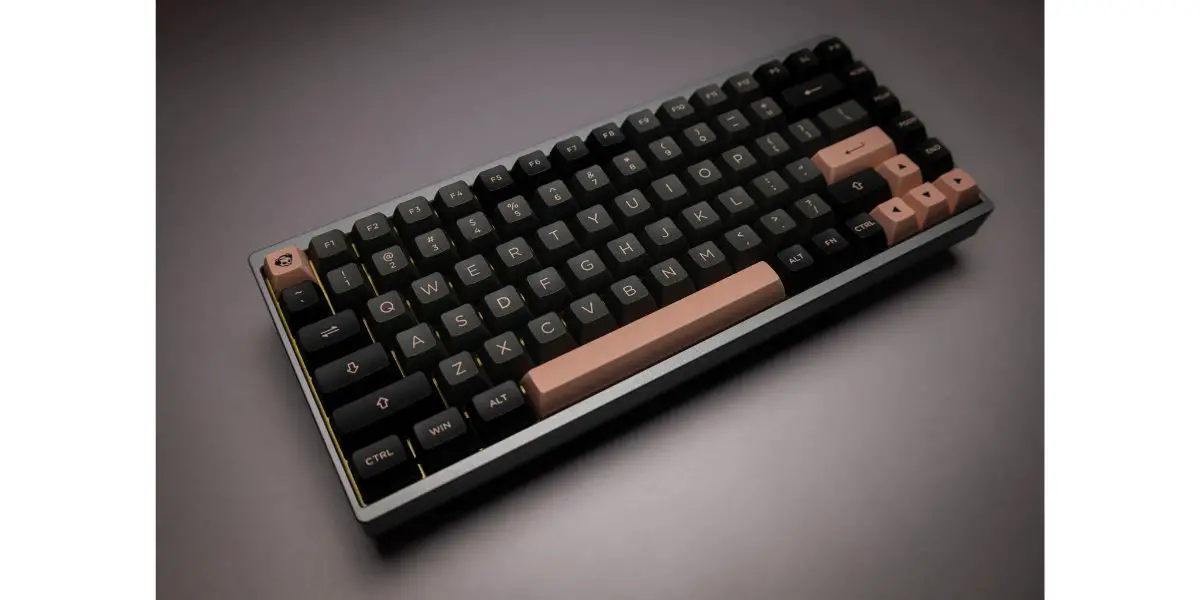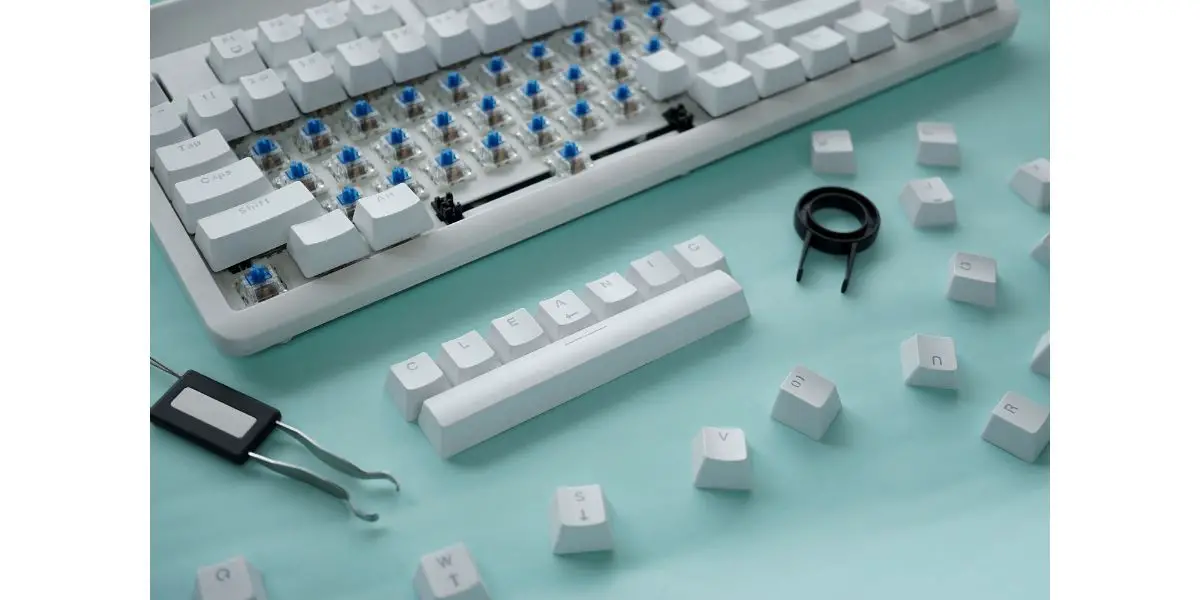Disclaimer: This post may contain affiliate links, meaning we get a small commission if you make a purchase through our links, at no cost to you. For more information, please visit our Disclaimer Page.
Mechanical keyboards still get ghosting. Often, the root cause of the problem is poor design, where the keyboard’s wiring isn’t efficient at registering multiple keystrokes. The keyboard software may also be the cause of the problem.
Table of Contents
Do All Mechanical Keyboards Have N-Key Rollover?
Before we dive into the specifics of keyboard ghosting, let’s look at one popular solution used by mechanical keyboard makers to eliminate ghosting.
Not all mechanical keyboards have N-Key rollover. Unless it’s specifically stated that your keyboard has that feature, it’s best not to assume that it can register all keys without ambiguity. Some keyboards like the CIY TES84 may label their rollover features collectively as “anti-ghosting”.
In short, if it’s not stated in the product description, there’s a chance that your mechanical keyboard does not support the feature.
N-key rollover is a popular technology used in the mechanical keyboard. This special feature allows users — especially gamers — to hold down an unlimited number of keys without ghosting.
A simple way to estimate how many keys your keyboard can register simultaneously is to press different numbers of keys at the same time and determine the maximum number that can be accurately registered. If your keyboard does not support the feature, it will stop registering when you press more than three, six, or ten keys, depending on how it’s built.
Unfortunately, the N-Key rollover (NKRO) feature applications in USB mechanical keyboards can be limited when you have an older mechanical keyboard. These antique keyboards used the USB protocol and could register up to 6 keys simultaneously.
At the time, the only way to enjoy full NKRO was through a PS/2 connector. Thankfully, recent advancements have leveled the playing field, with modern mechanical keyboards being able to support NKRO through USB.
How Keyboard Ghosting Happens
Don’t you just hate when your lightning-speed typing gets interrupted by a keyboard that won’t register some keystrokes? Gamers, too, often run into a similar problem when holding down more than three keys to make their character move, hide, or attack.
Ghosting occurs in most (if not all) keyboards and is a situation where a set of keys (usually in three or more combinations) pressed at the same time do not register a keystroke on the computer screen.
The result is an annoying lag that slightly lowers your productivity and ruins your gaming experience.
From a different perspective, ghosting is a phenomenon that also occurs when multiple keys are pressed simultaneously on a keyboard, but different/unexpected characters appear out of the blue. For instance, if you hold down the w, a, s, and d keys together but get the letter h on the screen.
Unfortunately, it can be difficult to pinpoint the keys affected the most by the phenomenon. However, ghosting will probably not become an issue for general keyboard use, like typing. The problem becomes much more evident in a fast gaming environment.
In many cases, keyboard ghosting is caused by the wiring and circuitry behind the individual keys. T o understand how the internal wiring affects your keyboard’s response, we need to go into the basic anatomy of an ordinary computer keyboard.
How a Mechanical Keyboard Works
A lot goes into the hardware design, but here’s the summary of the inner workings of a keyboard:
The Grid Column
Keyboards are usually wired in a grid column, which is also called a key matrix. Each key sits atop an intersection of a row and column wire (essentially, a switch). When you hold down any key, it makes contact with the row and column wire intersection below it, which completes a circuit.
When the keyboard’s processor receives the information, it pinpoints the location of the key by scanning for any closed circuits (contact points) between each row and column wire.
Some keyboards use diodes and capacitors, which may feature a slightly different working mechanism.
On a typical keyboard, when only one key is held down, ghosting will not be a problem. Two to three keys held down are also not an issue. However, holding more than three keys simultaneously may present a challenge when they share both a row and a column.
The Reporting Protocol
The grid column is a basic design feature of most keyboards. Normally, it should work for a broader number of keys, but another problem stands in the way: the reporting protocol.
The standard reporting protocol determines the number of keys that can be reported at the same time. In most keyboards, you can hold down between three to six keyboard keys without ghosting.
More keys may appear indistinguishable to the program, especially if they share a row and column in the key matrix. In this case, the keyboard protocol won’t report ambiguous keys to avoid providing inaccurate feedback.
Anti-ghosting features help solve these issues through a wide variety of methods. For instance, some keyboards use extra wires or a different wiring arrangement. Often, this only pushes the problem to the less commonly used keys, where the user is less likely to encounter it.
How To Resolve the Ghosting Issue
While it’s considerably difficult to eliminate ghosting if it exists on your keyboard, there are design choices and keyboard options that will make it much less likely to occur.
The best way to avoid ghosting is to switch to a keyboard that supports N-Key rollover. These keyboards have each key reported independently so that any combination can be registered.
However, there are more ways to prevent ghosting as follows:
Clean Your Keyboard
Sometimes, ghosting stems from a filthy keyboard with dust and debris trapped between the keys. For cleaning, you’ll need an old toothbrush, a cap-pulling tool, and a small screwdriver.
Remember, keyboard keys are held in place by delicate structures that can break easily under excessive force. As such, I recommend researching your keyboard’s structure and using the right tools to remove every key carefully.
Here’s a video that demonstrates how to clean your keyboard safely:
Also, take a picture of the key arrangement for reference when reinstalling the keys.
Switch to a High-Quality Keyboard With Anti-Ghosting Technology
The next time you purchase a keyboard, choose one with anti-ghosting technology. Low-quality mechanical keyboards are made from cheap plastic parts and sometimes have no N-Key rollover support.
And while not all mechanical keyboards have anti-ghosting, the vast majority of modern mechanical keyboards use anti-ghosting technologies.
For instance, the Corsair K95 RGB Mk 2 (available on Amazon.com) features multi-key anti-ghosting technology that ensures all your keys are registered while gaming.
Choose a Keyboard With Keys That Are Easy To Push
If your keyboard features sturdy, hard-to-push keys, you could fail to get a response when you apply insufficient force to the keys and mistake this for ghosting. Oftentimes, mechanical keyboards are regarded as easy to type on.
However, if you have a thick keyboard with stiff keys, you must apply more pressure to successfully register keystrokes.
Finally, you can switch to a hybrid mechanical keyboard, which combines mechanical switches with membrane keyboard elements. Combining the best features of both technologies, hybrid keyboards offer the tactile feel of a mechanical keyboard without sacrificing responsiveness.
Conclusion
Ghosting, no matter how insignificant, can be annoying. If you want to get rid of it altogether, I highly recommend investing in a high-quality N-Key rollover mechanical keyboard from a trustworthy manufacturer.


